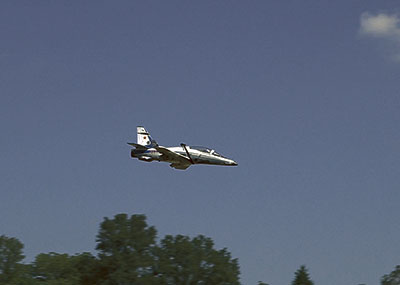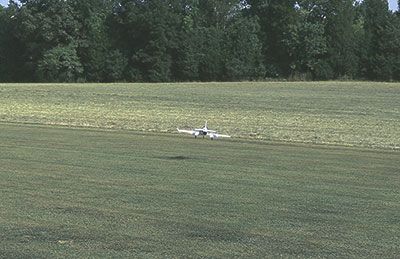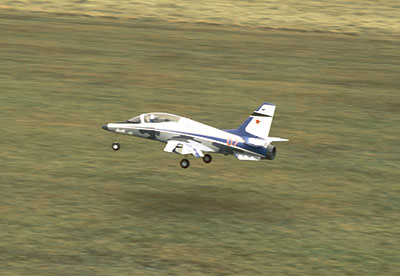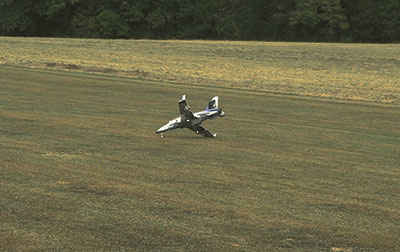|
|||||
FlyingRC.net is a
Veteran-Owned site.

 |
| The E-Flite Viper 70mm EDF turned out to be a great flying EDF jet with impeccable manners in the sky and on grass. Click image to enlarge |
E-Flite Viper 70mm EDF Maiden
A high-speed “puppy” in the sky
Text photos by Tom Hintz
Flight video by Dennis Shaver
Posted – 9-9-2019
I should preface this by noting that the E-Flite Viper 70mm EDF maiden will also be my jet maiden. I’ve never flown a model jet before though I have been accused of trying to make a jet noise on the flight line when one of my gassers flew down the runway. Unfortunately, what they heard was a different type of gas entirely and replicated the jet sound accidentally.
Maiden morning turned out to be ideal, scattered clouds, 80’s with generally light, variable winds that at times got a little gusty. That bit of wind proved the E-Flite Viper 70mm EDF is not a fair-weather flier. The weather also meant I had no legitimate excuse to justify postponing the E-Flite Viper 70mm EDF maiden.
First Flight
On the first takeoff my jet novice-ness reared its ugly head as I circled the field trying to dial in enough up elevator to fly straight and level at speed. On the third circuit I noticed that the wheels and half flaps were still down. I was watching for what I thought might be “jet stuff” to happen and whiffed putting it into normal flight configuration.
With the flaps and gear up I had to un-trim the elevator which allowed the E-Flite Viper 70mm EDF to fly virtually hands-off at speed. Subsequent flights would show me the E-Flite Viper 70mm EDF wants to fly cleanly, and that pilot error is likely the best way to make it act up in the air. Make believe I did all that just to show you what not to do.
The E-Flite Viper 70mm EDF does have a difference in how it flies at full throttle and at an idle. When trimmed to fly straight and level at full throttle, it wants to nose down somewhat with the power off, especially with flaps deployed. I either need to make a couple flight modes or dial in a touch of up elevator when full flaps are deployed for landing. Either way the elevator correction needed is small.
 |
| This is the moment the E-Flite Viper 70mm EDF broke free of the ground for the first time. The only surprise to me was how easy it was to handle. Click image to enlarge |
Retracts and Grass
Like most of you, I heard the near-constant pooh-pooing of small wheels and/or retracts on grass. I wondered how well the E-Flite Viper 70mm EDF would handle the grass runway that I fly off. Despite that collective Internet gnashing of the teeth, the E-Flite Viper 70mm EDF flies off and back onto grass just fine. By the last flight of the day I was doing my incessant touch-and-goes, on grass, with an EDF jet.
I found that using the first level of flaps on takeoff gets the E-Flite Viper 70mm EDF out of the grass quickly. Also, the E-Flite Viper 70mm EDF remained stable as it rose from the ground with no tendency to wobble or stall. As it accelerated, I retracted the gear and flaps and the E-Flite Viper 70mm EDF was up to speed with full control authority.
The coiled gear legs do have some spring to them in response to bumps in the grass but that is much less of an issue than I anticipated. I did manage to do a couple larger hops (on camera naturally) and one sort of sideways, abrupt stop. The gear held up fine and I took off again before landing for the day. No damage to the gear legs or the gear mounting in the foam.
Battery Life
I was using Spektrum Smart™ 6S, 3200mAh, 30C LiPo packs which gave me around 3-1/2 minutes of flight time. That left around 30% of the battery capacity after the flight. It is important to note that individual flying habits (say throttle usage) can have a huge impact on the flight time.
In the Air
The E-Flite Viper 70mm EDF was surprisingly stable and easy to fly. Know, there is lots of manufacturer-based verbiage about this being a good “starter” jet and while that turned out to be true, I am always wary of such claims. Kudos to Horizon Hobby on this one, the E-Flite Viper 70mm EDF is a very easy plane to fly.
Where you can get in trouble quickly is allowing the E-Flite Viper 70mm EDF to get too far out as it gets tough to see because of its overall size, thin profile and on cloudy days the camouflage color scheme. All this is to be expected with such a small plane going this fast. It gets very small, very quickly so the pilot needs to be “turning and burning” constantly or the E-Flite Viper 70mm EDF could be burning somewhere out of sight.
 |
 |
| I found that half-flaps (left) worked perfectly for take off and many landings. The E-Flite Viper 70mm EDF is not picky! Of course, you knew I had to mess up one landing (right) and do it on camera. It's in the video and caused no damage to the E-Flite Viper 70mm EDF at all. Click images to enlarge |
|
Despite the 30C battery lacking the punch of more substantial packs, the E-Flite Viper 70mm EDF has good vertical. Here again, its overall size makes too much vertical a dangerous thing. On one of my first vertical tests I had to re-orient myself to the model on the way down.
Now with the first day of flying the E-Flite Viper 70mm EDF complete I want to increase aileron and rudder throw to see if that livens up the roll rate and rudder authority. I am used to huge control throws and this jet thing is a different animal. I must find the middle ground between a great flying jet and one that I can make do unusual things while still missing the ground.
I never adjusted the AS3X stabilization system, opting to stay at the setup that came along with the model file for my Spektrum iX12 transmitter. The amount of correction we could see just moving the plane around on the bench seemed to be very small, but it may be more effective than I know. The good thing is that I never felt it was interfering with my control inputs.
Also, I did not enable the SAFE Select system. I have tried that system on other planes, and it is too limiting for me. It’s a great thing for new pilots and may be helpful when teaching some pilots. Remember, if you use the SAFE Select system, it will right the plane if you lose control, but you must fly it back to you or the crash will be farther away. If you need this system, you need an instructor pilot to help you.
Conclusions
The reputation for being easy to fly is well deserved by the E-Flite Viper 70mm EDF. Considering the E-Flite Viper 70mm EDF to be a good first RC plane requires a near total disconnect from reality. It is, however, a great platform for an RC pilot with intermediate skills to get into EDF jets. As always, if you are uncomfortable taking a jet on by yourself, seek out an instructor to help you move into this class of RC plane without killing the plane on the way.
Video Tour |
All my flying experience with the E-Flite Viper 70mm EDF shows me that it is predictable, stable and easy to land, including in moderate winds. Before flying the E-Flite Viper 70mm EDF I would not have thought any of those traits to be possible in a foamy jet.
Have a comment on this Review? Email Me!
All Flyingrc.net written, photographic and drawn materials are property of and copyright by Tom Hintz and Flyingrc.net 2013-2020 Materials cannot be used in any way without the prior written permission of the owner.
Privacy Statement


